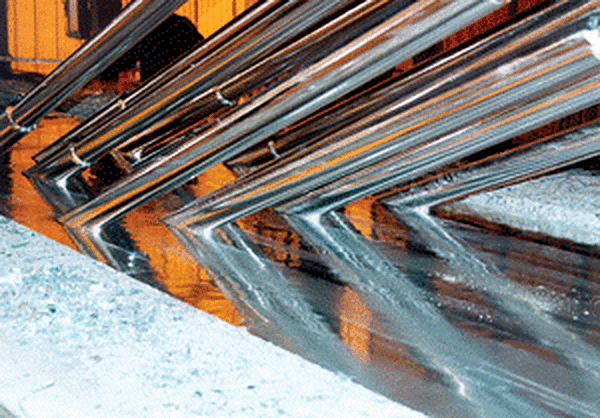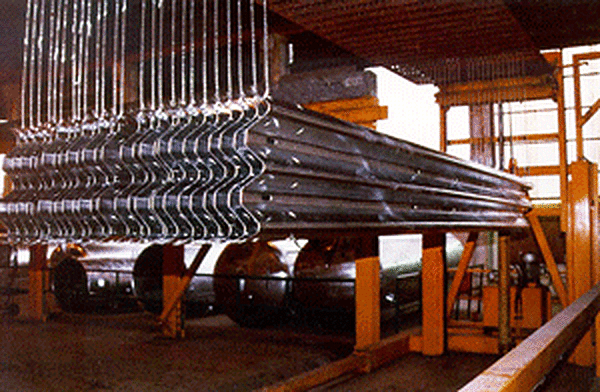Stripping and Regalvanizing
My galvanizer informed me of a coating defect that cannot be repaired, so the part must have the coating removed and then re-galvanized. What does this do to the mechanical properties of the steel and should I have any concerns with respect to design?
Hot-dip galvanized steel can be stripped and re-galvanized for several reasons such as:
- The galvanized steel came out of the kettle with bare areas exceeding the limits outlined in Section 6.2 of ASTM A123/A123M or in Section 4.5 of ASTM A153/A153M.
- Steel with reactive chemistry was galvanized which caused the coating to grow to excessive levels (>10 mils) and then flaked off the steel.
- The galvanized steel has been in service for some time and the coating is nearly consumed.

When galvanized steel is stripped and re-galvanized, the same chemical cleaning process used prior to galvanizing is also used to strip the zinc coating from the surface of the steel. Some galvanizers even have a separate acid bath used specifically for this purpose. A small amount of steel which reacted with the zinc to form the initial galvanized coating is lost in this process. However, this amount is usually negligible unless dealing with extremely low dimensional tolerances.
Chemical Cleaning a second time can change the surface profile or chemistry of the steel which affects the properties of the galvanized coating. For example, some very reactive steels that develop an excessively thick coating and are rejected due to flaking can benefit from re-galvanizing because some of the silicon (a catalyst in the galvanizing reaction) is partially consumed in the first coating process. This leads to a thinner coating upon re-galvanizing. Conversely, steel chemistries which produce too thin of a coating may also benefit from re-galvanizing in order to change the surface profile and meet the required minimum coating thickness average.
For galvanized steel which has previously been in service, it is important to note that stripping and re-galvanizing the coating will not fill in dimples and holes in the steel, but rather follow the shape of steel and reveal what the steel surface looked like before re-galvanizing.
Galvanized bolts cannot be re-used after they have been brought to a specified tension and then taken out of service1. This is a general rule within the fastener industry which has very little to do with the bolt being stripped and re-galvanized2. The galvanizer should be informed of any previously tensioned bolts. Additionally, there have been several studies conducted to observe the effects of hot-dip galvanizing on the mechanical, fracture, and microstructure properties of various steel types:
Influence of Hot-Dip Galvanizing Technology on the Properties of Hot-Dip Galvanized Steels by Mittal Steel Ostrava, Vysoka Skola Banska
This study involved running four types of steel through the galvanizing process to determine the effects of individual steps during the galvanizing process on the mechanical properties, impact strength, and microstructure of the tested steels. Testing of mechanical properties included upper yield point, ultimate strength, and ductility. The results of the test concluded differences in mechanical properties of steels that were not galvanized and those that were galvanized was negligible and galvanizing does not have any effect on mechanical properties of steel.
Galvanizing Characteristics of Structural Steels and their Weldments by BNF Metals Technology Centre and ILZRO
Testing conducted in this study determined hot-dip galvanizing does not affect tensile strength, proof strength, bend, or impact properties of structural steels. Small changes in some mechanical properties were detected after steel that had been cold-worked went through the galvanizing process. Larger bend radii were found to lessen these effects on cold-worked steels that were later galvanized.
Does Galvanizing Affect Steel Strength? by Industrial Galvanizers Corporation Pty Ltd.
The aim of this study was to determine if any particular step in the hot-dip galvanizing processes affects the yield strength of high-strength steel. Uncoated (black) steel and pre-galvanized sheet steel (which was stripped) were also tested. The results of the tests showed the difference between the non-galvanized steel and pre-galvanized sheet steel had a variation in yield strength of less than 1%, which was within the accuracy tolerance of the testing procedure. In other words, the tests found galvanizing did not affect the yield strength of either black steel or pre-galvanized sheet steel that had been stripped and then re-galvanized.
In Summary

It can be stated that the hot dip galvanizing process does not have any influence on mechanical, fracture, and microstructure properties of steels with various compositions and strengths. Chemical Cleaning the steel a second time can cause a change in surface profile or chemistry which will affect the properties of the galvanized coating. Additionally, chemical cleaning does not increase the chances for hydrogen embrittlement for steel with a tensile strength <150ksi. However, steels with a tensile strength >150ksi can absorb hydrogen if stripped or pickled in an acid bath, and alternate methods may be required for coating removal (i.e. mechanical cleaning such as blasting).
The designer should consider the small amount of steel that reacts with zinc to form the initial coating which is lost in the stripping and re-galvanizing process. They will want to evaluate the effect of this material loss and consult their galvanizer if you have any critical dimensions with very small dimensional tolerances.
References
1Specification for Structural Joints Using High-Strength Bolts, June 11, 2020. Prepared by RCSC Committee A.1—Specifications and
approved by the Research Council on Structural Connections.
2Bowman,
M. and Betancourt, M. (1991), “Reuse of A325 and A490 High-Strength Bolts,”
Engineering Journal, Vol 28, No. 3 (3rd Qtr.), AISC, Chicago, IL.
© 2025 American Galvanizers Association. The material provided herein has been developed to provide accurate and authoritative information about after-fabrication hot-dip galvanized steel. This material provides general information only and is not intended as a substitute for competent professional examination and verification as to suitability and applicability. The information provided herein is not intended as a representation or warranty on the part of the AGA. Anyone making use of this information assumes all liability arising from such use.

